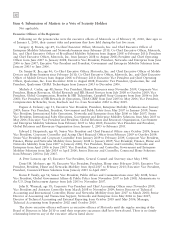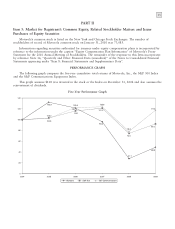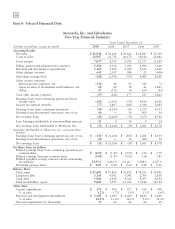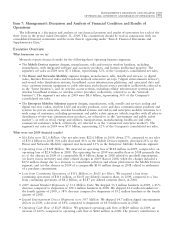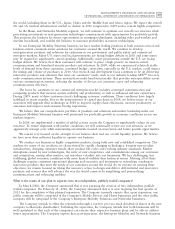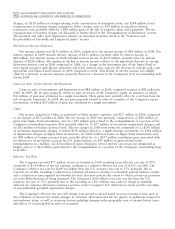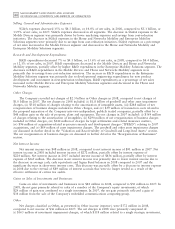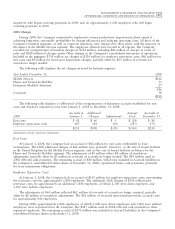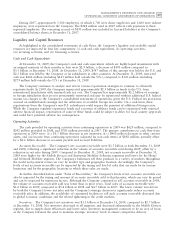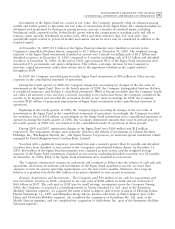Motorola 2009 Annual Report Download - page 50
Download and view the complete annual report
Please find page 50 of the 2009 Motorola annual report below. You can navigate through the pages in the report by either clicking on the pages listed below, or by using the keyword search tool below to find specific information within the annual report.
42 MANAGEMENT’S DISCUSSION AND ANALYSIS
OF FINANCIAL CONDITION AND RESULTS OF OPERATIONS
charges, (ii) $318 million of charges relating to the amortization of intangible assets, (iii) $248 million of net
reorganization of business charges included in Other charges, and (iv) $59 million of separation-related
transaction costs, partially offset by a $48 million gain on the sale of property, plant and equipment. The net
reorganization of business charges are discussed in further detail in the ‘‘Reorganization of Businesses’’ section.
The goodwill and other asset impairment charges are discussed in further detail in the ‘‘Valuation and
Recoverability of Goodwill and Long-lived Assets’’ section.
Net Interest Income (Expense)
Net interest expense was $132 million in 2009, compared to net interest income of $48 million in 2008. Net
interest expense in 2009 includes interest expense of $213 million, partially offset by interest income of
$81 million. Net interest income in 2008 included interest income of $272 million, partially offset by interest
expense of $224 million. The significant decline in interest income reflects: (i) the significant decrease in average
short-term interest rates in 2009 compared to 2008, (ii) a change in the investment mix of the Sigma Fund to
more liquid securities with shorter maturities and lower interest rates, and (iii) the decrease in average cash, cash
equivalents and Sigma Fund balances in 2009 compared to 2008. This decline in interest income was slightly
offset by a decrease in interest expense, primarily driven by a decrease in the Company’s level of outstanding debt
during 2009.
Gains on Sales of Investments and Businesses
Gains on sales of investments and businesses were $88 million in 2009, compared to gains of $82 million in
2008. In 2009, the net gain primarily relates to sales of certain of the Company’s equity investments, of which
$32 million of gain was attributed to a single investment. These gains were partially offset by a net loss from the
sale of specific businesses. In 2008, the net gain primarily related to sales of a number of the Company’s equity
investments, of which $29 million of gain was attributed to a single investment.
Other
Net income classified as Other, as presented in Other income (expense), was $27 million in 2009, compared
to net charges of $372 million in 2008. The net income in 2009 was primarily comprised of: (i) $80 million of
gains from Sigma Fund investments, and (ii) a $67 million gain related to the extinguishment of a portion of the
Company’s outstanding long-term debt, partially offset by: (i) $77 million of investment impairment charges, and
(ii) $52 million of foreign currency losses. The net charges in 2008 were primarily comprised of: (i) $365 million
of investment impairment charges, of which $138 million related to a single strategic investment, (ii) $186 million
of impairment charges on Sigma Fund investments, (iii) $101 million of losses on Sigma Fund investments, and
(iv) $84 million of foreign currency losses, partially offset by: (i) a $237 million curtailment gain associated with
the decision to freeze benefit accruals for U.S. pension plans, (ii) $56 million of gains related to the
extinguishment of a liability, (iii) $24 million of gains relating to several interest rate swaps not designated as
hedges, and (iv) a $14 million gain related to the extinguishment of a portion of the Company’s outstanding long-
term debt.
Effective Tax Rate
The Company recorded $77 million of net tax benefits in 2009, resulting in an effective tax rate of 47%,
compared to $1.6 billion of net tax expense, resulting in a negative effective tax rate of (61)%, in 2008. The
Company’s effective tax rate for 2009 was higher than the U.S. statutory tax rate of 35% primarily due to
research tax credits, including a reduction in valuation allowances relating to refundable general business credits
and a reduction in unrecognized tax benefits for facts that now indicate the extent to which certain tax positions
are more-likely-than-not of being sustained. The Company’s 2008 effective tax rate was less than the U.S.
statutory tax rate of 35% primarily due to the recording of a $2.1 billion non-cash tax charge to establish
deferred tax valuation allowances against a portion of the Company’s U.S. deferred tax assets and the recording
of non-deductible goodwill impairment charges.
The Company’s effective tax rate will change from period to period based on non-recurring events, such as
the settlement of income tax audits, changes in valuation allowances and the tax impact of significant unusual or
extraordinary items, as well as recurring factors including changes in the geographic mix of income before taxes
and effects of various global income tax strategies.


